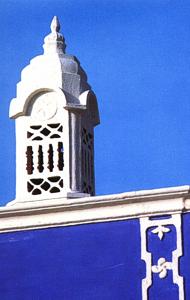|
Tourism |
|
| Portugal > Tourism > Algarve > São Brás de Alportel | |
| History | Places of Interest | Lodging | Lodging Algarve | Handicrafts | Gastronomy | |
|
|
|
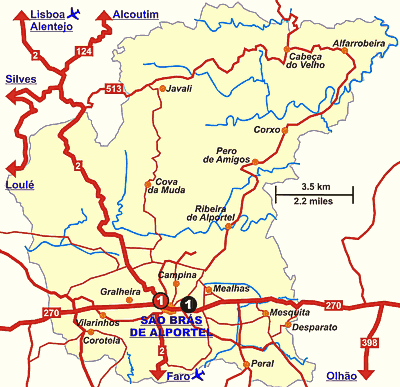 |
| History |
|
The area that is now the municipality of São Brás de Alportel, in common with the Algarve as a whole, was inhabited in prehistoric times and in the days of the Romans. Birthplace of the Moorish poet Ibne Ammar in the 12th century, São Brás de Alportel was by the 16th century a small village with a Hermitage. From the 17th century onwards it was the summer residence of the bishops of the Algarve, who were drawn to it by its agreeable climate, and in the 19th century it became the crossroad of the routes linking Loulé to Tavira and Faro to Almodôver. The area's extensive plantations of cork oak provided a spring board for commercial and industrial development and for years São Brás de Alportel was the biggest cork producing centre in Portugal and the world. Its increasing population and economic importance led to the creation of the municipality in 1914. The gradual transfer of the cork manufacturing industry to the centre and north of Portugal has prompted the municipality in recent decades to diversify its sources of economic prosperity. |
| Places of Interest |
|
A walk in the Barrocal
Villages nestling between hills. Walls of whitewashed stone flashing in the sun. The lush foliage of almond, fig, carob and pomegranate trees. The bright colours of windows and doors standing out from plain facades. From Mesquita, with its typical water mill, through the picturesque villages of Desbarato Mealhas, Gralheira and Vilarinhos, this route offers a fascinating insight into the Barrocal, the intermediate country that lies between the coast and the hills of the interior. Up into the hills |
|
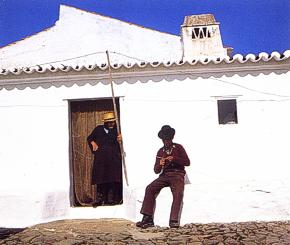 |
|
These are among the attractions of an itinerary that
takes in Cova da Muda, Javali, Cabeca
do Velho and its windmill and, on the way back down, Corches.
Pero de Amigos and Ribeira de Alportel.
|
| The tranquil, unhurried lifestyle of the friendly local population.
Streets of white houses whose ranks are broken only by the lofty outline
of the church and its bell tower. The ring of hills around, the town
that look out on the sea and the mountains. Such are the simple charms
of São Brás de Alportel, a typical Algarve town. Historical Centre Low, white houses typical of popular architecture stand alongside more substantial buildings, their facades decorated with tiles, ornate stonework and cast iron verandas, whose opulence harks back to São Brás de Alportel's prosperity, in the years when the cork industry was booming. The high and low points of the towns changing fortunes are thus written in the stones of its streets and squares; while such details as the baroque mortar decoration of the Passo da Paixão (Stations of the Cross) near the Episcopal Palace and the pretty flower pots in the windows add colour and interest to their story. |
|
Main Church
Built on the site of a church that probably dates back to the 15th century, the current structure was rebuilt after the earthquake of 1755. It was extended considerably in the 19th century. The interior is rather lacking in architectural interest. The chapel of Senhor dos Passos (Lord of the Stations of the Cross) contains gilded carvings in the taste of the second half of the 18th century and there are paintings from the 17th century depicting saints. Among the statues to be seen, those of the arcanjo São Miguel (Archangel Michael), São Libório (St. Liborius) and Santa Eufemia (St. Euphemia), dating from the 18th century are worth mentioning. The statues in the sacristy are from the same period. In the baptistery there is a neoclassical retable in marble. The churchyard is a good vantage point to admire the surrounding countryside and the sea. Former Episcopal Palace Built in the 17th/18th centuries for the bishops of the Algarve as a place of refuge from the summer heat, this building underwent several modifications in the 19th and 20th centuries which have altered its structure. What remains of the original palace today is part of the main building and, almost opposite it, a baroque vaulted fountain with eight spouts. |
|
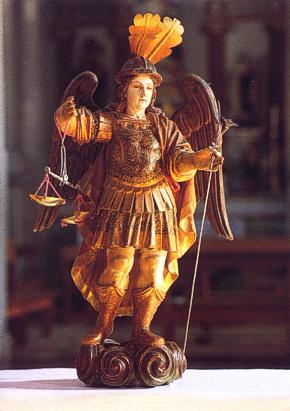 |
| António Bentes Cultural Centre (Algarvean Costume Ethnographic
Museum) Located in what was once the home of a wealthy muleteer who grew rich in the cork trade, this building is a good example of bourgeois architecture at the end of the 19th century. In addition to an exhibition of the typical Algarvean costume worn in the 19th/20th centuries, there is also a collection of popular religious sculpture. The old farm buildings contain about twenty old vehicles once used in the Algarve, ranging from carriages and buggies that were the favoured mode of transport of the rich to mule carts and ox drawn wagons used by farmers and farm labourers. The museum also includes an exhibition of agricultural implements and tack and an area dedicated to cork and the cork industry. |
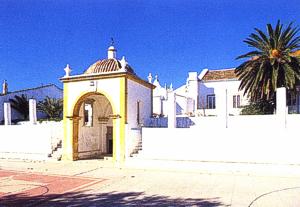 |
|
 |
| Handicrafts |
|
Many of the region's traditional crafts still thrive
in São Brás de Alportel, as can be seen from the brooms
and brushes made with palm leaves in Soalheira, the
objects woven from coarse esparto grass in Peral, Alfarrobeira
da Tumba, the stonemasonry of Corotelo and the
panniers and baskets of Desbarato. Tiles and bricks
are still produced by hand in Vale de Mealhas, wrought
iron work in Vilarinhos and Gralheira.
Craftsmen in Vilarinhos also make wooden spoons, miniature copies
of typical local carts and children's toys, while Camping is known
for its chairs, and Gralheira for its brasses are. The mill in
Cabeca do Velho still use; nothing but the Rind and millstone,
to grind corn and wheat into flour that tastes as it aid centuries
ago.
|
|
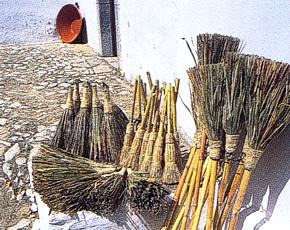 |
| Gastronomy |
|
In São Brás de Alportel the local cooking
is marked by the perfume of fresh herbs picked in the hills, whether
it be the oregano used in Gazpacho or the pennyroyal in the thick
bread soup known as açorda. In the hunting season the rich,
gamey flavours of wild rabbit in wine are not to be missed. Kid with
peas, chicken, fried with garlic, eggs with tomato and chickpeas with
eggs are all a familiar sight on dinner tables in country kitchens.
São Brás de Alportel is known for its almond confectionery which is especially popular at Easter time. Also much appreciated is the spirit slowly distilled from the fruit of the arbutus berry trees that grow in the hills, which is also used to make excellent herbal liqueurs. |
| Lodging |
|
S. Brás de Alportel Pousada was the first Pousada to be built in the Algarve, in 1942, and the second in Portugal. Only half an hour from the Algarve coast and Faro airport, it is perfect place to savour the Algarve, avoiding the more crowded coastal resorts. As for gastronomy you can enjoy delicious fish together with excellent Portuguese wines. |
|
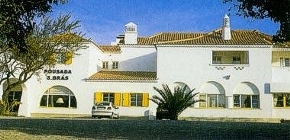 |
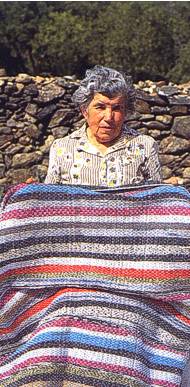 |
|

|
| History | Places of Interest | Lodging | Lodging Algarve | Handicrafts | Gastronomy | |
| Portugal > Tourism > Algarve > São Brás de Alportel | |
|
São
Brás de Alportel |
|

